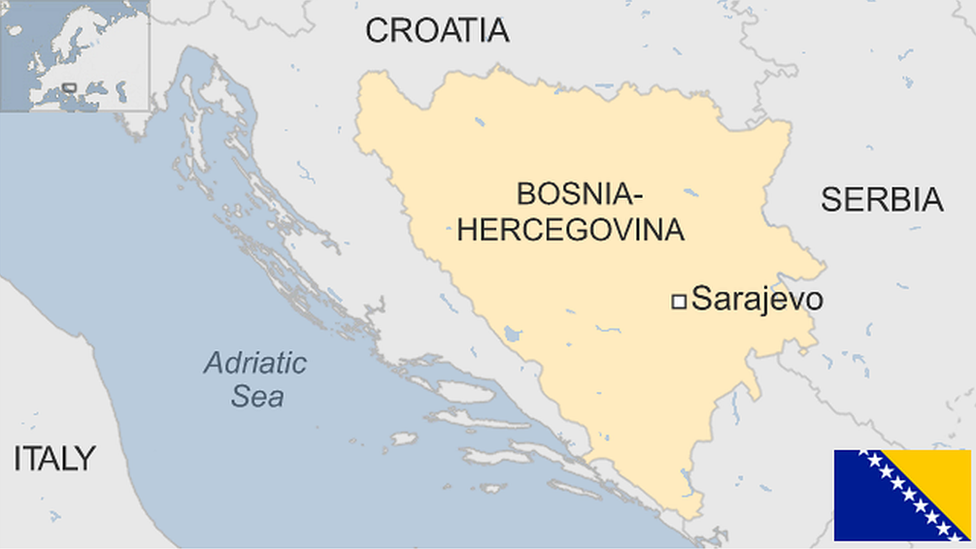[Getty Images]
Ethnic divisions and the differences between the entities that make up Bosnia are evident in the media scene, and outlets run by the individual entities are more popular than the state-wide public broadcaster.
Divisions between the entities that make up Bosnia-Herzegovina are reflected in the media.
A lack of political consensus is reflected in the late rollout of digital TV and delays in passing laws on media ownership and public media funding.
TV is still the most popular medium but use of online media is increasing.
TV and radio outlets in Bosnia’s two ethnic-based entities are more popular than the state public broadcaster, while commercial outlets struggle to make a profit in the crowded media market.
There are around 40 TV channels including three operated by public broadcasters, and 150 radio stations registered with the Communications Regulatory Agency.
The Austrian archduke Franz Ferdinand and his wife Sophia on their fateful visit to Sarajevo in June 1914 [Getty Images]
Some key dates in the history of Bosnia-Herzegovina:
1908 – Ottoman province of Bosnia-Herzegovina annexed by Austria-Hungary.
1914 – A Bosnian Serb student, Gavrilo Princip, assassinates the Austrian Archduke Franz Ferdinand in Sarajevo. This precipitates World War One.
1918 – Austria-Hungary collapses at the end of the war. Bosnia-Herzegovina becomes part of the future Yugoslavia.
1941 – Bosnia-Herzegovina annexed by pro-Hitler Croatian puppet state. Thousands of Serbs, Jews and Gypsies are sent to the death camps.
1945 – Bosnia-Herzegovina liberated following campaign by Communist partisans.
1945-1991- Bosnia is part of Socialist Federal Republic of Yugoslavia.
1992 – Following collapse of communism, Croat and Muslim nationalists form tactical alliance and outvote Serbs at independence referendum.
1992-1995 – Bitter ethnically-rooted civil war involving Bosnian Muslims, Serbs, and Croats. Serbs quickly assume control of over half the republic. Killings and deportations are rampant in the newly-proclaimed Serb Republic, but also widespread in Muslim and Croat-controlled areas.
Civilians and Bosnian troops under Serbian sniper fire during the siege of Sarajevo in 1992 [Getty Images]
1995 – Safe haven of Srebrenica is overrun by Bosnian Serb forces under General Ratko Mladic, who massacre over 8,000 Muslims.
1995 December – Dayton Peace Accord creates two entities, one for Serbs and one for Bosnian Muslims and Croats. The Office of the High Representative is created to oversee its implementation. An international peacekeeping force is deployed.
2016 – Former Bosnian Serb leader Radovan Karadzic is convicted of genocide and war crimes for his role in the war.
Bosnia formally applies for EU membership.
2017 – Former Bosnian Serb military commander Ratko Mladic is found guilty of genocide and crimes against humanity during the Bosnian War. He is sentenced to life imprisonment.
2021 – Serb nationalist leader Milorad Dodik announces the RS will withdraw from Bosnia’s military, its top judiciary body and tax administration, prompting renewed fears of a secession crisis.
2024 – Bosnia begins EU membership negotiations.
Sarajevo is the political, financial, social and cultural centre of Bosnia and Herzegovina [Getty Images]
Source link : http://www.bing.com/news/apiclick.aspx?ref=FexRss&aid=&tid=670f23aa0dfe48b6ab7fbd351f03cba9&url=https%3A%2F%2Fau.news.yahoo.com%2Fbosnia-herzegovina-country-profile-090257493.html&c=16950796067077936486&mkt=de-de
Author :
Publish date : 2024-10-10 22:02:00
Copyright for syndicated content belongs to the linked Source.
